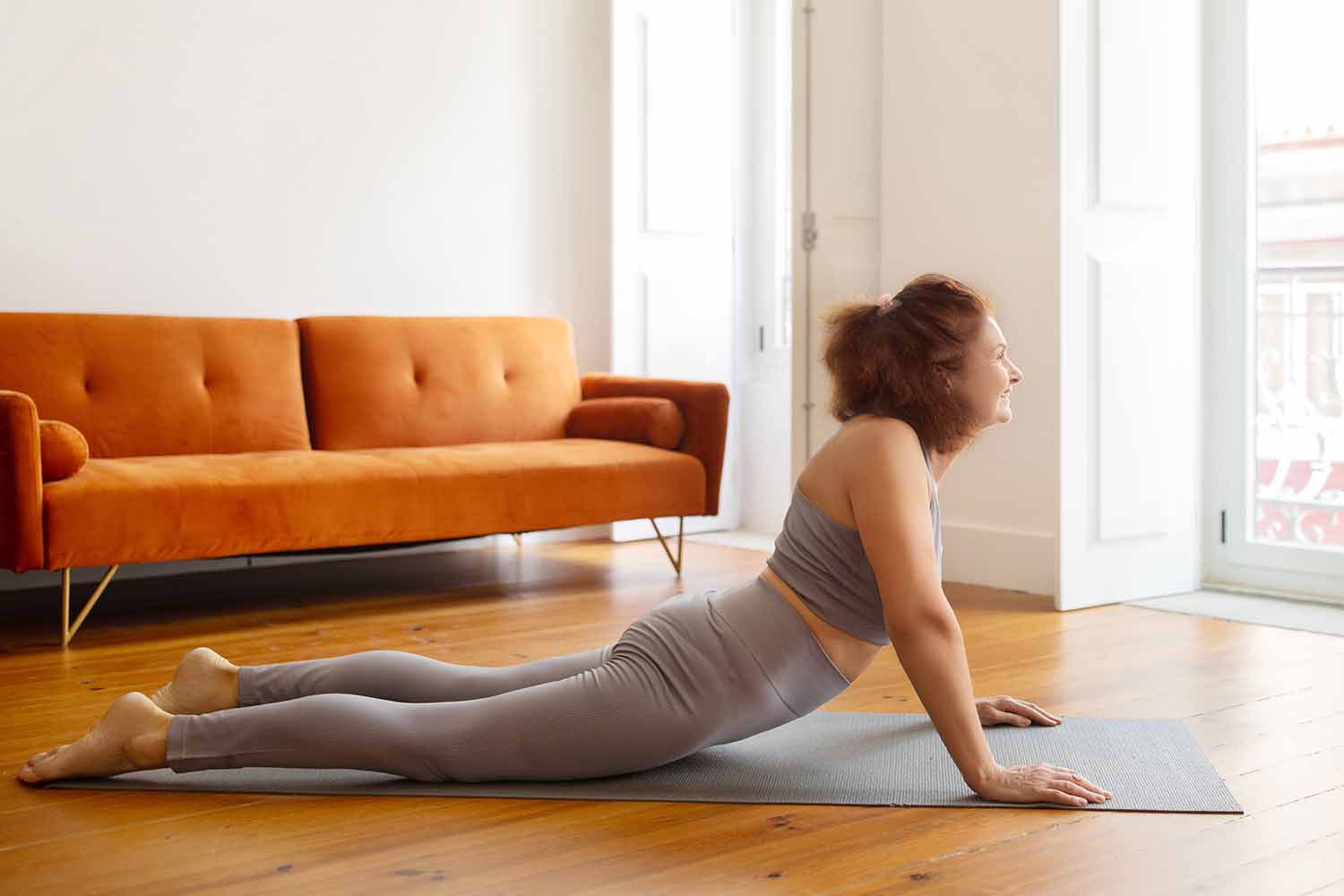In yoga, certain poses stand out as both grounding and empowering. Sphinx Pose, known as Salamba Bhujangasana in Sanskrit, is a gentle backbend yoga pose that helps in strengthening the spine and opening the chest. Sphinx Pose in yoga is suitable for practitioners of various levels, including beginners. It’s a great way to gently introduce backbending into your practice and build strength in the back muscles. This pose is often used as a preparatory pose for deeper backbends, and it can also be therapeutic for those with mild back discomfort. Whether you’re a yoga novice seeking a foundational pose or an advanced practitioner refining your practice, Sphinx Pose beckons you to embrace a journey of self-discovery and strength.
Other Names for Sphinx Yoga Pose
Known by different names in various yoga traditions, Sphinx Pose is also referred to as:
- Salamba Bhujangasana (Sanskrit)
- Low Cobra Pose
How to do Sphinx Pose in Yoga
Follow these steps to gracefully enter Sphinx Pose:
- Start prone: Begin by lying on your stomach with your legs extended and the tops of your feet resting on the mat.
- Place your elbows: Position your elbows directly under your shoulders, with your forearms parallel to each other.
- Align your wrists: Ensure that your wrists are in line with your elbows, and your palms are pressing into the mat.
- Engage your core: Activate your abdominal muscles to support your lower back.
- Lift your chest: Inhale as you gently lift your chest off the mat, keeping your shoulders relaxed away from your ears.
- Lengthen your neck: Extend your neck forward while keeping your gaze at a point on the mat, avoiding compression in the neck.
- Hold the pose: Maintain the pose for 15-30 seconds, breathing deeply and consistently.
- Release with care: Exhale as you carefully lower your chest back down, resting your forehead on the mat.
Variations of Sphinx Yoga Pose
Explore different variations of Sphinx Pose to add depth to your practice:
- Forearm Placement: Experiment with different forearm placements, such as bringing the elbows wider or closer together.
- Sphinx Seal: Press the palms together, creating a seal with the forearms parallel, to intensify the stretch.
Modifications for Sphinx Yoga Pose
For a more accessible experience, consider these modifications:
- Elbow Placement: If you experience discomfort, adjust the placement of your elbows to find a comfortable position.
- Leg Position: Place a folded blanket under your hips for added support, particularly if you have lower back sensitivity.
Contraindications for Sphinx Pose in Yoga
While Sphinx Pose is generally safe for most practitioners, individuals with the following conditions should approach the pose with caution:
- Back Issues: If you have a history of back injuries or discomfort, consult with a healthcare professional before attempting Sphinx Pose.
- Carpal Tunnel Syndrome: Individuals with wrist issues may find it more comfortable to use props or modify the pose.
Tips to Improve Sphinx Yoga Pose in Your Practice
- Focus on Length: Prioritize lengthening the spine over height to maintain a safe and sustainable backbend.
- Activate Core Muscles: Engage your core to support the lower back and create stability in the pose.
- Gentle Neck Extension: Extend the neck gently, avoiding strain, and keep the gaze downward to protect the cervical spine.
What Muscles Does Sphinx Pose Work?
Sphinx Pose engages various muscle groups, including:
- Erector Spinae: Activated to lift and extend the spine.
- Abdominals: Engaged to support the lower back and maintain stability.
- Shoulder Muscles: Involved in supporting the weight of the upper body.
Mental and Emotional Benefits of Sphinx Pose in Yoga?
Beyond its physical impact, Sphinx Pose offers mental and emotional advantages:
- Heart Opening: The gentle backbend is associated with opening the heart center, fostering a sense of vulnerability and compassion.
- Stress Reduction: The pose may help alleviate mild stress and anxiety, promoting a sense of calm.
- Grounding Energy: Sphinx Pose is grounding, encouraging practitioners to connect with the earth beneath them.
Is Sphinx Yoga Pose Suitable for Beginners and Advanced Practitioners?
Sphinx Pose is beginner-friendly, providing an opportunity to introduce the body to the principles of backbending.
Is Sphinx Yoga Pose Suitable for Beginners and Advanced Practitioners?
Advanced practitioners can deepen the pose by exploring variations, such as a deeper backbend or incorporating it into more dynamic sequences.
How Does Sphinx Pose Contribute to a Yoga Sequence or Flow?
Sphinx Pose seamlessly integrates into a yoga sequence in the following ways:
- Warm-Up: Used as a gentle warm-up to prepare the spine for deeper backbends.
- Cool Down: Incorporated into the cool-down phase to counterbalance forward bends and inversions.
- Restorative Practice: Applied in restorative practices to encourage relaxation and heart opening.
How Can I Deepen My Practice in Sphinx Pose?
Deepening your practice in Sphinx Pose involves:
- Incremental Progression: Gradually increase the height of your backbend over time, respecting your body’s signals.
- Regular Practice: Include Sphinx Pose regularly in your practice to build strength and flexibility in the spine.
- Breath Awareness: Coordinate your breath with the movement to cultivate a more mindful and integrated experience.
Common Mistakes in Teaching Sphinx Yoga Pose
To ensure a safe and effective practice, avoid these common teaching mistakes when guiding students in Sphinx Pose in yoga:
- Neglecting Core Engagement: Emphasize the importance of engaging the core to provide support for the lower back.
- Overlooking Neck Alignment: Stress the significance of maintaining a gentle neck extension and keeping the gaze downward to protect the cervical spine.
- Ignoring Individual Differences: Remind students that each practitioner’s Sphinx Pose may look different based on their unique anatomy, and that’s perfectly acceptable.
In conclusion, Sphinx Pose invites practitioners to embrace both the strength and serenity inherent in the practice of yoga. As you embody the gentle backbend, let your heart open, and allow the energy to flow through your entire being. Whether you’re new to yoga or a seasoned practitioner, Sphinx Pose is a bridge to self-discovery and empowerment. So, inhale deeply, lift your heart, and embody the grace and strength of Salamba Bhujangasana.
Namaste.

